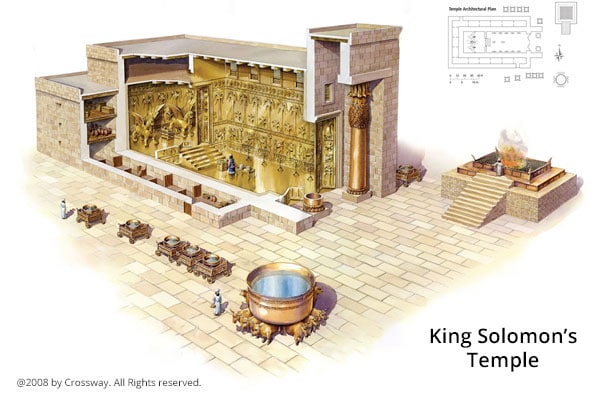Bible Question:
How were people able to hear the priest's readings in the temple?
Bible Answer:
The question we are concerned with is could someone hear a priest speak in Solomon’s temple? That is, were the temple accoustics so exceptional that everyone in Solomon’s temple could hear the priests speak? In order to answer this question, we will learn how the temple was built and then what the acoustics of the temple were. Then we can answer the question.

Dimensions of Solomon’s Temple — 1 Kings 6 & 1 Chronicles 3
Both 1 Kings 6:1-35 and 2 Chronicles 3:1-14 describe the construction of King Solomon’s temple. The two descriptions have some differences. 1 Kings 6:11-13 uniquely contains God’s promise to Solomon that He will not forsake Israel if they will keep His commandments. 1 Kings 6 describes the windows of the temple, but 2 Chronicles does not. 2 Chronicles 3:14 is the only passage that describes the veil.
Both passages provide dimensions of the temple. For example, 1 Kings 6:2 and 2 Chronicles 3:3-4 both state that the temple was sixty cubits long and twenty cubits wide . Only 1 Kings 6:2 says the height was thirty cubits.
As for the house which King Solomon built for the LORD, its length was sixty cubits and its width twenty cubits and its height thirty cubits. 1 Kings 6:2 (NASB)
Since the average cubit is about 18 inches, this means the temple was 90 feet or 27.432 meters long, 30 feet or 9.144 meters wide and 45 feet or 13.716 meters in height. Verse 3 states that there was a porch in front of the temple. Verse 4 says the temple had windows. Verse 6 says the temple had three stories or three flours.
1 Kings 6:7-10 says the temple was made of stone blocks. Each of the three stories were 5 cubits or 7.5 feet or 1.524 meters high.
The house, while it was being built, was built of stone prepared at the quarry, and there was neither hammer nor axe nor any iron tool heard in the house while it was being built. The doorway for the lowest side chamber was on the right side of the house; and they would go up by winding stairs to the middle story, and from the middle to the third. So he built the house and finished it; and he covered the house with beams and planks of cedar. He also built the stories against the whole house, each five cubits high; and they were fastened to the house with timbers of cedar. 1 Kings 6:7-10 (NASB)
Verse 9 states on the inside the temple the walls and floors were covered with planks of cedar. Finally, 1 Kings 6:14 says that King Solomon’s temple was finished. So, what were the acoustics like inside the temple?
So Solomon built the house and finished it. 1 Kings 6:14 (NASB)

Could Someone Hear A Priest Speak In Solomon’s Temple?
Joseph De Buglio, an acoustic sound engineer with JdB Sound Acoustics, states that at this point in the construction of King Solomon’s Temple, it would have been very difficult to hear a priest speak in the temple. That is, the acoustics would have been terrible.
When the walls of Solomon’s temple were up and the ceiling was installed all of the walls and floor were bare stone. The noisy reflections would have been so strong that any conversation beyond 5 ft would have been marginal and at 8 ft impossible. Sure, you might understand a word here and there but nothing intelligible.[1]
Later in 2019, the author updated this comment with the following statement.
Shell of the Holy of Holies was a cube. The room was the resting place for the Ark of the Covenant. The acoustical requirements of this room was to hear clear speech up to 3 meters (10 feet) in a room 30 x 30 x 30 feet (30 feet = 9.1 meters.) What would a person experience in a cube-shaped room with nothing but flat walls? Such a room would ring so much that at 3 meters, understanding what a person would be saying would be impossible. For a cube room to support speech, there has to be something else in the room to control the sound to allow speech at that distance.[2]
Both statements strongly make the point that it would have been difficult for two people to communicate in the temple unless they were very close to each other, not to mention a priest reading Scripture for everyone to hear.
Boards of Cedar Added
At this point it is important to notice that 1 Kings 6:15 says King Solomon covered the walls with cedar wood and the floors with cypress wood. 1 Kings 6:16 says boards of cedar were added to the rear from the floor to the ceiling of the temple.
Then he built the walls of the house on the inside with boards of cedar; from the floor of the house to the ceiling he overlaid the walls on the inside with wood, and he overlaid the floor of the house with boards of cypress. He built twenty cubits on the rear part of the house with boards of cedar from the floor to the ceiling; he built them for it on the inside as an inner sanctuary, even as the most holy place. 1 Kings 6:15-16 (NASB)
Why did this occur after the temple was finished (v.14)? The answer could be that it was an attempt to solve the acoustics of the temple.
Gourds and Open Flowers Added
Next, 1 Kings 6:18 adds that shapes like gourds and flowers in full bloom were carved into the cedar. The Hebrew word for “carved” is miqlaat. The word is normally translated as “engraving” in 1 Kings 6:18, 29, 32; 7:31. The “gourds” and open flowers may have been placed around the edges of the cedar. Their location is not explicitly stated.
There was cedar on the house within, carved in the shape of gourds and open flowers; all was cedar, there was no stone seen. 1 Kings 6:18 (NASB)
Mr. De Buglio believes this was an attempt to solve an acoustics problem in the temple.
From my point of view, this looks like a first attempt at treating the room acoustics. I would also speculate that this attempt failed and was not enough.[3]
Cherubim and Palm Trees Added
Other changes were made (v. 28) in an apparent attempt to solve an acoustics problem. That seems to be the message of in 1 Kings 6:28-29 when cherubim and palm trees were added.
He also overlaid the cherubim with gold. Then he carved all the walls of the house round about with carved engravings of cherubim, palm trees, and open flowers, inner and outer sanctuaries. 1 Kings 6:28-29 (NASB)
It is odd that palm trees were added to the inside of the temple. Why palm trees? Mr. De Buglio believes that the new construction solved the acoustics problem.
This one obscure and often overlooked verse unlocks a key that gave Solomon satisfaction. It says “And he carved all the walls of the house round about with carved figures of cherubim and palm trees and open flowers, within and without.” Soon as these carvings were mounted on the walls – all of the walls, it would have changed how Solomon’s temple would have sounded. It had to have.
. . . .
The most likely reason for the Palm Trees is to solve a BIG problem.
. . .
Somehow Solomon discovered that diffusion is the most effective way to control sound in the speech and musical range. The half round shape is the most efficient. How this miraculous discovery was made, no one knows but one thing is for sure, it works! How well does it work?[4]
This solved the acoustics problem. Mr. De Buglio explains in his document Solomon’s Temple Great Acoustics that initially he tested the effectiveness of half-round shapes on walls and ceilings to solve acoustics problems in churches. It worked. He installed half-round shapes on walls and ceilings in over four hundred and fifty churches to solve acoustical problems by April 2020. His firm continues to do so today.
It should be noted that the veil mentioned in 2 Chronicles 3:14 would have helped with acoustical issues too! But we are not told when the veil was added relative to the additional work described in 1 Kings 6:15-29. It is important to note that 2 Chronicles 3:1-17 is an overview of the more detailed and sequential description given in 1 Kings 6:1-35.
Conclusion:
Ultimately, the overall design and detail of the temple was directed by the Lord God. It was given to King David. But the construction was left to King Solomon.
“All this,” said David, “the LORD made me understand in writing by His hand upon me, all the details of this pattern.” 1 Chronicles 28:19 (NASB)
Could someone hear a priest speak in the temple? If Mr. Joseph De Buglio is correct, the answer is, “Yes!”
References:
1. Joseph De Buglio. “Well, not really a “secret” but King Solomon did lay down the ground work to Modern Day Church Acoustics.” Solomon’s Temple Great Acoustics. November 2011. (www.jdbsound.com)
2. Joseph De Buglio. “What Does the Bible Teach Us About Church Sound?” 2019.
3. Joseph De Buglio. “Well, not really a “secret” but King Solomon did lay down the ground work to Modern Day Church Acoustics.”Ibid.
4. Ibid.